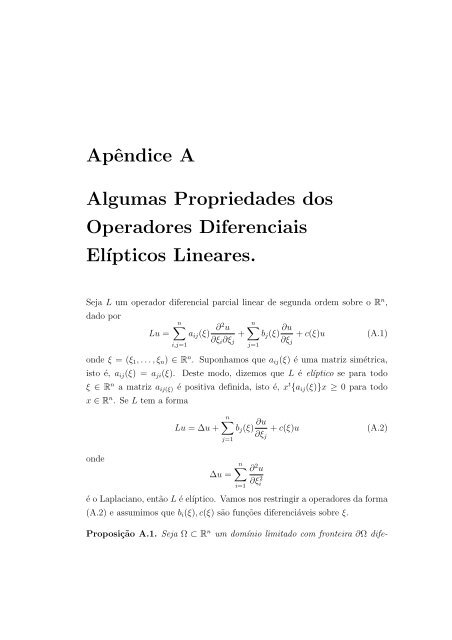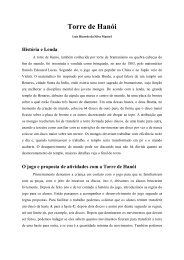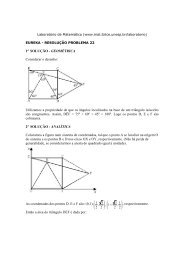Ricardo Nicasso Benito A Reduç˜ao de Liapunov-Schmidt ... - Unesp
Ricardo Nicasso Benito A Reduç˜ao de Liapunov-Schmidt ... - Unesp
Ricardo Nicasso Benito A Reduç˜ao de Liapunov-Schmidt ... - Unesp
You also want an ePaper? Increase the reach of your titles
YUMPU automatically turns print PDFs into web optimized ePapers that Google loves.
Apêndice A<br />
Algumas Proprieda<strong>de</strong>s dos<br />
Operadores Diferenciais<br />
Elípticos Lineares.<br />
Seja L um operador diferencial parcial linear <strong>de</strong> segunda or<strong>de</strong>m sobre o R n ,<br />
dado por<br />
Lu =<br />
n<br />
i,j=1<br />
aij(ξ) ∂2 u<br />
∂ξi∂ξj<br />
+<br />
n<br />
j=1<br />
bj(ξ) ∂u<br />
∂ξj<br />
+ c(ξ)u (A.1)<br />
on<strong>de</strong> ξ = (ξ1, . . . , ξn) ∈ R n . Suponhamos que aij(ξ) é uma matriz simétrica,<br />
isto é, aij(ξ) = aji(ξ). Deste modo, dizemos que L é elíptico se para todo<br />
ξ ∈ R n a matriz aij(ξ) é positiva <strong>de</strong>finida, isto é, x t {aij(ξ)}x ≥ 0 para todo<br />
x ∈ R n . Se L tem a forma<br />
on<strong>de</strong><br />
Lu = ∆u +<br />
n<br />
j=1<br />
∆u =<br />
bj(ξ) ∂u<br />
∂ξj<br />
n<br />
i=1<br />
∂ 2 u<br />
∂ξ 2 i<br />
+ c(ξ)u (A.2)<br />
é o Laplaciano, então L é elíptico. Vamos nos restringir a operadores da forma<br />
(A.2) e assumimos que bi(ξ), c(ξ) são funções diferenciáveis sobre ξ.<br />
Proposição A.1. Seja Ω ⊂ R n um domínio limitado com fronteira ∂Ω dife-






